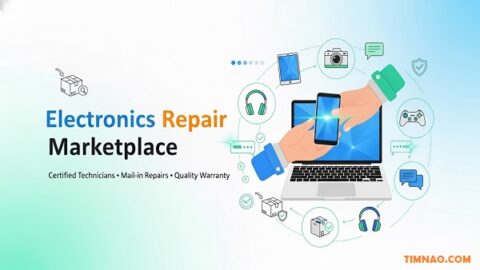Home Appliance Service Center: Profitable Ultimate Startup Blueprint 🚀
Idea Overview & Why It Matters
A home appliance service center is a business that keeps households and small businesses running by fixing essential appliances and replacing worn-out parts. Think fridges, washing machines, air conditioners, ovens, microwaves, vacuum cleaners, and more. When these break, life gets stressful very quickly.
Instead of people throwing away half-working machines or guessing which technician to trust, your center becomes the professional, reliable place they call first. You offer diagnostics, repairs, and spare parts replacement, so their appliances last longer and work safely.
This idea matters more than ever because:
- New appliances are getting more expensive.
- Consumers are becoming more aware of sustainability and reducing waste.
- The right-to-repair movement is pushing people to fix, not toss.
- Many markets still lack a clearly branded, trustworthy, mid-priced appliance repair business.
You’re not just fixing machines. You’re selling peace of mind, convenience, and savings—and getting paid again and again as appliances inevitably fail over time.
Target Customers & Problems Solved
Different customer groups feel the pain of broken appliances in different ways. The more clearly you understand this, the better you can design your services, pricing, and marketing.
Households & Families
Who they are:
Families, couples, roommates, people living alone—anyone with essential appliances at home.
Key problems:
- They don’t know who to trust. They’ve heard stories about technicians who overcharge or do low-quality work.
- Replacing a fridge or washing machine is a big financial hit, especially for young families or people on tight budgets.
- They hate disruption: no fridge means wasted food; no washing machine means chaotic laundry plans.
- They worry about safety, especially with older or faulty electrical devices.
What they want most:
Quick, professional help; clear pricing; someone who shows up when promised and does the job properly.
Landlords & Property Managers
Who they are:
Owners or managers of apartments, condos, rental homes, serviced residences, or multi-unit buildings.
Key problems:
- Every broken appliance becomes a tenant issue—and unhappy tenants mean complaints, bad reviews, or even vacancies.
- They often manage multiple properties, making it painful to coordinate many different technicians.
- Repairs can feel unpredictable: different prices, slow responses, mixed quality.
- They need documentation and invoices for their accounting.
What they want most:
One reliable point of contact who can handle appliance issues across their units, with predictable pricing and quick response times.
Small Businesses & Offices
Who they are:
Cafés, bakeries, salons, clinics, co-working spaces, and small offices that rely on appliances like fridges, ovens, coffee machines, water dispensers, or air conditioners.
Key problems:
- When an appliance fails, they lose revenue (e.g., melted ice cream, spoiled food, unhappy customers).
- Many don’t have the volume to justify an in-house technician.
- They need repairs to be done outside of peak business hours where possible.
- They want professional documentation and often require digital invoices.
What they want most:
Fast, business-friendly repairs and scheduled maintenance that prevent breakdowns during peak times.
Hostels, Homestays & Short-Term Rentals
Who they are:
Hostel owners, guesthouse operators, and hosts on platforms like Airbnb or Booking.
Key problems:
- Their appliances are used heavily by guests and fail more frequently.
- A broken AC or washing machine can lead to bad reviews and lost bookings.
- They need trusted local partners they can call whenever guests report issues.
What they want most:
Fast, reliable, on-call service and clear communication when something can’t be fixed immediately.
Value Proposition & Business Model
Let’s turn this into a clear, simple business engine: who pays, why they pay, and how money flows.
What Value You Actually Deliver
You’re not only repairing devices. You’re delivering:
- Continuity – life and business can continue without major disruption.
- Savings – repairing is often far cheaper than replacing.
- Safety & reliability – correct parts and proper installation reduce fire or shock risks.
- Convenience – customers don’t have to carry heavy appliances; you come to them or arrange pickup.
- Sustainability – repairing reduces electronic waste and aligns with eco-conscious values.
Your promise could be summarized as:
“We keep your essential appliances running safely, affordably, and with zero guesswork.”
Why Customers Will Pay
Customers pay because the cost of not fixing the problem is higher than the repair cost:
- A frozen fridge full of food that spoils can cost more than the repair.
- A non-functioning AC in a rental unit can lead to bad reviews or tenant churn.
- A broken washing machine creates stress and additional time costs (e.g., using laundromats).
When you present your pricing clearly and show your professionalism (uniform, branding, communication, mini warranty), people are comfortable paying fair rates—and coming back again.
How the Business Makes Money
Here are common revenue streams for a home appliance service center:
- Diagnostic fee: A fixed fee for inspecting the appliance and giving a quote (e.g., $10–$25). Sometimes deducted from the final repair cost.
- Repair labor: Charge per job or per hour (e.g., $30–$80+ depending on complexity and market).
- Spare parts replacement: You buy parts from distributors and apply a markup (e.g., 30–60%) to cover sourcing, storage, and warranty risk.
- Maintenance contracts (AMC): Monthly or yearly contracts with landlords, hostels, and small businesses for regular checkups and priority repairs.
- Urgent / after-hours fees: If someone needs evening or weekend service, they pay a premium for faster response.
Simple Example Numbers (Illustrative Only)
Imagine you’re operating in a mid-income city:
- Average diagnostic fee: $15
- Average repair labor per job: $40
- Average parts sold per job: cost $30, sold at $50
For a typical repair:
- Revenue = $15 (diagnostic) + $40 (labor) + $50 (parts) = $105
- Direct costs might be: $30 (parts cost) + $10 (transport, wear on tools, basic overhead) = $40
- Approximate gross profit: $65 per job before your own salary and general overhead.
If you handle 60 jobs in a month, that’s 60 x $65 = $3,900 gross profit potential.
These numbers are not promises, but they show why this model can become attractive once you have steady volume.
Lean Validation Plan (First 30–45 Days)
Before renting a big shop or hiring a team, you should prove demand and refine your offer. Here’s a lean, step-by-step plan.
Step 1: Market Scan (Days 1–5)
Objective: Understand your local landscape and find gaps.
Actions:
- Search “[your city] appliance repair” on Google Maps and note:
- Who appears in the top results
- Their ratings and number of reviews
- Services they mention (brands, appliance types, home visits, etc.)
- Read 20–30 customer reviews, especially negative ones. Write down recurring complaints, such as:
- “Didn’t show up on time”
- “Price changed after the job”
- “Temporary fix; broke again”
- Check marketplaces and local Facebook or community groups to see how people talk about repair services.
Outcome: A list of 3–5 gaps you could fill, like “clear fixed pricing,” “faster response,” or “genuine parts guarantee.”
Step 2: Customer Interviews (Days 3–10)
Objective: Talk directly to potential customers and hear their stories.
Target:
- Neighbors
- Friends and family
- Local hosts, small café owners, or property managers
Sample questions:
- “When was the last time an appliance in your home or business broke?”
- “What did you do about it?”
- “What frustrated you the most about the process?”
- “How did you find the technician, and how confident did you feel about the price and quality?”
- “If there was a professional, branded home appliance service center with clear pricing and a short warranty, would that feel safer or more convenient to you?”
- “Which appliances worry you most when they start making weird noises?”
Don’t sell hard in these conversations; listen. The goal is to understand language, fears, and priorities.
Outcome: Clear phrases and pain points you can use in your marketing and service design.
Step 3: Draft a Simple Offer & Landing Page (Days 7–15)
Objective: Turn your findings into a clear, testable offer.
Steps:
- Choose 1–2 appliance types to focus on first, e.g.:
- “Washing machine & fridge repair”
- “AC cleaning & repair”
- Write a simple value proposition, e.g.:
“Premier Home Appliance Service in [City] – Fast, transparent repair for washing machines & fridges, with genuine parts and 30-day service warranty.”
- Create a basic landing page using a tool like WordPress or a simple site builder. Include:
- Services you cover
- Service area (neighborhoods)
- Clear pricing starting points
- A call-to-action: “Call / WhatsApp now” or simple booking form
- Add trust elements:
- Your name and photo
- Short “about” section
- Any relevant experience
Outcome: A clear online “home” for your offer that you can send to people.
Step 4: Get First Leads or Test Customers (Days 15–45)
Objective: Turn conversations into paying jobs and learn from real work.
Actions:
- Message your warm contacts:
“Hey [Name], I’ve started a new home appliance service focusing on [appliance type] in [area]. I’m offering a discounted diagnostic + repair for the first [X] customers in exchange for feedback and an honest review. Do you or anyone you know have a [appliance] that needs checking?”
- Post in local groups with a similar message, linking to your landing page.
- Print a simple flyer and place it in your building, nearby apartments, or local shops.
- Aim to get at least 5–10 real jobs in this stage, even at slightly lower prices, to:
- Test your repair process
- See how long jobs actually take
- Learn what customers appreciate or complain about
Outcome: Actual field data: time per job, typical issues, parts needed, what people are willing to pay, and which marketing channels worked best.
Operations, Tools & Minimal Setup
You don’t need a big showroom and complex systems on day one. But you do need solid basics for operations and tools.
Core Activities
Your daily operations will usually follow this pattern:
- Inquiry & booking – customer contacts you via phone, messaging app, or website.
- Initial screening – you ask basic questions about the brand, model, symptoms, and location.
- Diagnosis – on-site visit or bringing the appliance to your small workshop.
- Quotation – clear breakdown of labor + parts + expected timeline.
- Repair & testing – doing the work, testing under real conditions, ensuring safety.
- Payment & service record – collecting payment and recording what was done.
- Follow-up – checking in after a few days to ensure everything’s working.
Design a simple checklist or form for each step so the process is consistent.
Essential Physical Tools & Equipment
Start with a lean but quality toolkit:
- Basic hand tools: screwdrivers, pliers, wrenches, socket sets
- Electrical tools: multimeter, insulation tester
- Cleaning tools: brushes, vacuum for dust removal, cleaning solutions
- Safety gear: gloves, safety glasses, insulated tools, masks
- A sturdy workbench and proper lighting in your workspace
As you specialize (e.g., in ACs or washing machines), you may add more specialized tools, but don’t overbuy at the beginning.
Simple Software Stack
You can run a surprisingly professional operation with a handful of free or low-cost tools:
- Website & content:
- WordPress for your site and blog
- Communication & scheduling:
- WhatsApp Business for messaging and quick catalogs of services
- Google Calendar for booking and route planning
- Job tracking & notes:
- Google Sheets or Notion for logging jobs, parts used, and customer details
- Trello for a simple “To do / In progress / Done” board for your repair queue
- Invoicing & payments (where available):
- Basic branding:
- Canva to create a simple logo, flyers, and social graphics
Pick tools you are comfortable with and keep your setup simple. The goal is to track every job and present yourself professionally, not to build a complicated IT system.
Minimal Workflow Example
- Customer finds you via Google Maps or a flyer and messages you.
- You collect details, schedule an inspection, and log the job in your sheet.
- You visit, diagnose, and either:
- Fix on the spot, or
- Order parts and schedule a follow-up visit.
- Once completed, you test, issue a simple invoice, and record the job and parts used.
- Two or three days later, you send a quick text:
“Hi [Name], just checking in—how is your [appliance] working after the repair?”
This small follow-up differentiates you and increases referrals.
Pricing Strategy & Basic Unit Economics
Pricing can make or break your appliance repair business. You want to be fair but sustainable, not the cheapest in town.
Tiered Pricing Structure
You can structure your services in three tiers:
- Entry Tier – Diagnostic & Basic Fixes
- Includes on-site inspection and simple repairs that don’t require parts.
- Example: $15–$30 depending on distance and market.
- Can be deducted from the final repair cost to reduce friction.
- Main Tier – Standard Repair with Parts
- Most of your revenue will likely come from here.
- Includes labor + necessary spare parts.
- Example: $60–$150+ depending on appliance and part cost.
- Premium Tier – Priority & Contract Services
- For businesses, landlords, and premium households.
- Includes guaranteed response times, regular maintenance, and possibly a hotline.
- Charged as monthly/annual contracts or premium call-out fees.
Basic Cost Structure
Common cost components:
- Direct labor: Your time or technician wages.
- Parts cost: What you pay wholesalers or distributors for spare parts.
- Transport: Fuel, vehicle maintenance, or ride costs.
- Overheads: Rent for workshop (if any), utilities, basic marketing, software tools.
- Admin & contingencies: Occasional redos, warranty claims, etc.
Understanding these helps you avoid “nice-looking” revenue that actually loses money.
Example Unit Economics (Illustrative)
Let’s say you perform a standard washing machine repair:
- Customer pays:
- $20 diagnostic (included in final price)
- $50 labor
- $60 for a replacement pump (your cost $40)
So:
- Revenue: $20 + $50 + $60 = $130
- Direct costs: $40 parts + $10 visit cost (fuel + time value) = $50
- Gross profit on job: $80
From that $80 you still cover:
- Part of your monthly overhead (rent, tools, marketing)
- Your own salary and profit margin
If your monthly overhead is $1,600 and you complete 50 similar jobs:
- Gross profit = 50 x $80 = $4,000
- After overhead ($1,600), you have $2,400 left for your own pay and reinvestment.
These numbers are just examples, but they show the importance of watching both revenue and costs.
Marketing & Acquiring First Customers
You don’t need fancy branding to start. You need a handful of people who trust you enough to try your service, then tell others.
Quick Wins for the First 10–20 Customers
Focus on low-cost, high-trust channels:
- Friends, Family, NeighborsMessage example:
“Hi [Name], I’ve just launched a Premier Home Appliance Service in [area], focusing on [appliance types]. For my first customers I’m offering a discounted diagnostic and repair in exchange for feedback and a review. Do you or anyone you know have an appliance that needs checking?”
- Local Community GroupsPost in local Facebook or WhatsApp groups:
- Introduce who you are
- Share 1–2 photos of your workspace or you in action
- List your starting services and areas covered
- Offer a small “launch discount” or “first 10 customers” promo
- Google Maps & Local Listings
- Create a profile with your business name, address (or service area), phone number, and working hours.
- Upload photos: your workshop, tools, and a simple logo.
- Ask early customers to leave honest reviews.
- Flyers & Posters
- Place simple flyers in apartment lobbies, local groceries, or laundromats.
- Focus on a clear headline:
“Fridge or Washing Machine Problems? Professional Repair in [Area]. Call [Number].”
Long-Term Channels (SEO, Content, Partnerships, etc.)
Once you’ve validated demand and are handling jobs regularly, invest in longer-term marketing assets.
- SEO & Content MarketingUse your WordPress site as a hub. Write simple articles such as:
- “5 Signs Your Fridge Needs Professional Repair (Before It Dies)”
- “How to Extend the Life of Your Washing Machine by 3+ Years”
- “Repair vs Replace: When Does Appliance Repair Make Financial Sense?”
These articles:
- Help you appear on search results over time
- Build trust by educating customers
- Turn you into a local authority, not just a repair person
- YouTube or Short-Form VideoShort videos showing:
- Basic maintenance tips
- “Behind the scenes” of your workshop
- Before/after results (with customer permission)
This content can be shared on social platforms and your site, reinforcing your professionalism.
- Partnerships with Appliance ShopsMany retailers don’t handle repairs well, especially after warranty expiry.Offer them:
- A fixed commission for each customer they refer
- Co-branded cards or flyers they can put next to the appliances
In return, you get steady referrals from people who just bought or already own appliances.
- Deals with Landlords & Property ManagersCreate a simple brochure or one-page PDF explaining:
- What you offer
- Your response times
- Example contract pricing for X units
Then visit or email property managers. This is often where you find repeat, high-value clients.
Risks, Challenges & How to Reduce Them
Every business idea has downsides. Your job is to see them early and plan around them.
Market Risks
- Heavy competition from existing repair shops or brand-authorized centers.
- Price-sensitive customers always chasing the cheapest option.
Mitigation:
- Differentiate with professionalism, clear pricing, and transparent communication, not just low prices.
- Specialize in specific brands or appliance types where you can be the best.
- Focus on service quality and reviews so you become the “trusted choice,” not the cheapest.
Operational Risks
- Inconsistent quality if you hire technicians without proper training.
- Scheduling chaos, missing appointments, or long delays.
- Safety incidents if repairs are done poorly.
Mitigation:
- Standardize repair procedures and use checklists.
- Start with tight scheduling and use tools like Google Calendar.
- Invest time in training and strict safety practices; never rush jobs that involve serious electrical issues.
Financial Risks
- Buying too many slow-moving spare parts that sit on shelves.
- Underestimating the time per job, leading to low effective hourly earnings.
- Extending too much credit to clients who pay late.
Mitigation:
- Start with small, fast-moving inventory; expand gradually based on real demand.
- Track time spent per job and regularly adjust pricing.
- For new B2B clients, start with partial upfront payment or shorter payment terms.
Scaling the Business Once It Works
You shouldn’t think about “scale” until the basics are working. So, what does “working” look like?
What “Working” Looks Like
You can say the model works when:
- You consistently get 10–20+ jobs per month with minimal marketing spend.
- At least 30–50% of your customers are repeat or referral clients.
- You have a clear sense of your average profit per job.
- Your reviews or feedback show customers trust you and are satisfied.
Once you’re there, scaling becomes a question of capacity and geography.
When to Hire or Outsource
Consider hiring when:
- You are consistently turning down work because you’re fully booked.
- You spend more time on the road and on admin than actually repairing.
- You see clear demand in nearby neighborhoods you cannot personally cover.
Start small:
- Hire one junior technician and train them on your methods.
- Use them first for simpler jobs or as support on bigger ones.
- Gradually shift yourself toward quality control, high-value repairs, and business development.
Expanding to New Segments or Regions
Growth options include:
- New appliance types: Once you dominate washing machines and fridges, add ACs, ovens, or small appliances.
- New neighborhoods or cities: Create mobile teams or micro-workshops in other parts of town.
- Specialization: For example, become the go-to center for a specific popular brand.
Each expansion should follow the same validate → test → standardize pattern you used at the start.
Additional Revenue Streams
Once your brand is recognized, you can explore:
- Selling care products: Descalers, filters, cleaning solutions, surge protectors.
- Refurbished appliances: Repair unfixable-for-customer units and resell them legally as refurbished.
- Online education: Simple paid workshops or courses on home appliance care for homeowners or junior technicians.
- Franchising or licensing: When your processes are solid, you might package them for other technicians in different areas.
Always protect your quality and reputation; these are your most valuable assets.
Key Lessons & Takeaways
- A home appliance service center is a practical, steady business that solves urgent, everyday problems for households and small businesses.
- Your real value is not just fixing machines—it’s delivering trust, convenience, savings, and safety through professional repairs and quality spare parts replacement.
- Start lean by focusing on 1–2 appliance categories, validating demand with real customers, and tracking time, costs, and customer feedback carefully.
- Use simple tools and systems to manage operations, pricing, and follow-up; then build recurring revenue with maintenance contracts and repeat clients.
- Manage risks by avoiding overstocking parts, underpricing, or rushing quality; grow only once you see consistent demand and positive reviews.
- When the model works, scale through hiring, new locations, new appliance types, and additional revenue streams—always anchored in reliability and professional service.
Disclaimer
The information in this article is provided for general educational and informational purposes only. It does not constitute business, financial, or legal advice. While every effort has been made to ensure accuracy, the strategies, examples, and figures presented are illustrative and may not reflect actual results. Running a business involves risk, and outcomes will vary based on location, skills, market conditions, and individual execution. Always conduct your own research and consult qualified professionals before making business, financial, or legal decisions. The author and publisher are not responsible for any losses, damages, or outcomes resulting from the use or misuse of the information provided in this article.
☕ Enjoyed This Guide? Support My Work!
If this article helped you build or refine your Home Appliance Service Center idea, consider buying me a coffee. Your support keeps me motivated to create more practical, beginner-friendly business guides.
👉 Buy me a coffee here: https://timnao.link/coffee 💛









